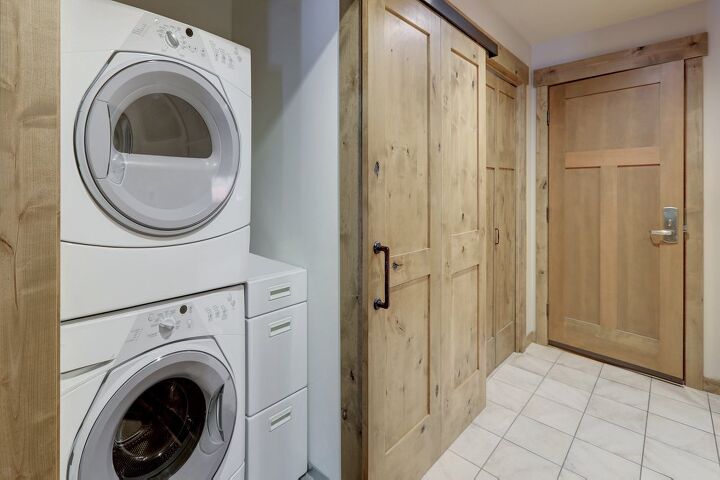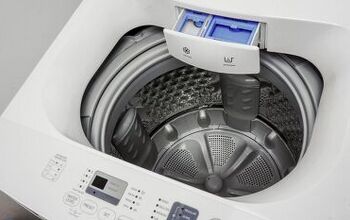What Are The Pros And Cons of Stacking a Washer And Dryer?

I’m obsessed with those beautiful laundry rooms on HGTV. If you have to spend long hours somewhere doing something as boring as laundry, at least the room could be beautiful. Maybe then the laundry would get folded and put away faster!
Sadly, I don’t think I’ll ever see my laundry room dreams realized. My house doesn’t have a laundry room. It has a laundry closet. On the bright side, my washer and dryer were built with stacking capabilities so I can save what little space I do have!
Stackable washers and dryers save so much space because they are designed with small spaces in mind. They are more energy-efficient and gentler on your clothes (and your body!).
Conversely, they tend to hold a smaller capacity and are best for small loads of laundry. They are also more high maintenance and expensive than their top-load counterparts.
Do You Need Appliance Installation or Replacement?
Get free, zero-commitment quotes from pro contractors near you.

Stacking Washer and Dryer Pros
There are several advantages of getting a stackable washer and dryer over top load units. Not only do they save precious space, but they also are more energy-efficient.
Space Saver
My sad laundry closet is actually big enough for a washer and dryer to sit side by side. There’s even enough room for a utility sink. Believe it or not, some laundry closets only have enough room for the stacked unit. Even though I can technically put my units side by side, I have them stacked in order to save space.
A standard washer and dryer are around 27 inches wide. Stackable washers and dryers are sized thusly:
- Height: 74-76 inches (when stacked)
- Width: 23-28 inches
- Depth: 27-32 inches
Even if you have plenty of space in your laundry area, stacking the washer and dryer gives you even more. With all the space you’ve saved, you can add things to your laundry room like a folding station or shelving for spill-over storage.
Energy Efficient
Who doesn’t want to save on their water bill? Front-load washers use less energy and water, making them more efficient than top-load units. In stackable combos, the drum releases the minimal amount of water needed to mix with the detergent instead of filling up completely.
It’s recommended that you only use high-efficiency detergent with front loads. Stackable units aren’t designed to handle the amount of suds other detergents produce.
Gentle on Clothes
In a top load washer, clothes get pummeled around the agitator. This mechanism sits in the middle of the drum and keeps the load moving during the wash cycle.
A front load washer tumbles the clothes gently and gives a more even wash to your clothes. Due to its gentle nature, a front load washer takes more time to complete a wash and rinse cycle. So, you’re sacrificing a quick cycle for a gently washed cycle. However, drying time may be cut down because clothes are wrung out well during the spin cycle.
Gentle on You
As a vertically challenged person, I loathe using top load washers and dryers. I often can’t reach down far enough to get the entire load. Even if you’re an average-size human, the constant bending a top load unit requires is a lot on your back.
With a front load unit, there is less bending required, though still some. Here’s a trick I discovered to avoid bending altogether. When my wash is done and ready to be dried, I open both doors and sit on the floor. Then, I toss handfuls of wet clothes up into the dryer.
It’s a little unconventional, but it saves my back. And you can’t do it with a top load washer!
Flexibility
Many stackable units are designed to also work side by side. This allows for flexibility in your laundry room layout. If you no longer want the units stacked, simply reverse the steps outlined in the installation instructions.
Of course, if you don’t have a full-blown laundry room, unstacking the units might not be an option.
Stacking Washer and Dryer Cons
Stackable washers and dryers are not without their disadvantages. Their capacity tends to be smaller than top-load units. Often stackable units require more maintenance, are more expensive, and only come with standard features.
Smaller Capacity
A standard washing machine usually has a drum measuring 3-4 cubic feet, while a compact stackable unit may only measure 2.5 cubic feet. This means it can only handle smaller loads of laundry. So, stackable units may not be ideal for big families are homeowners who constantly run their washers.
On a positive note, you can often wash and dry blankets and bulky bedding better in a front-load unit. This is due to the open drum. In top load units, the agitator can take up too much space, making bulky items difficult to wash.
Some stackable units are able to hold larger capacities, though bigger drums come with a larger price tag. A larger unit also can take up more space, which negates a stackable unit’s space-saving properties.
More Expensive
Smaller sizes don’t always equal lower prices. Stackable washers and dryers—even compact combos—can run anywhere from $1,000 to $2,000. If you decide to buy separate units with stacking capabilities, you could pay that much per unit.
Compare this to top load units which range in price from $275 and $450 for a standard model. But because of all the pros we talked about before, it might be worth paying double for a stackable unit.
More Maintenance
Simply because of their design, front load washers and dryers require more maintenance than top load units. Stackable washers especially have more places that need attention.
Mold builds up quickly in the rubber gasket so that should be cleaned often. If you wipe it down after every load, it should keep build-up from occurring. After you’re finished using the washer, keep it open to let it air dry. This helps any leftover water to evaporate more quickly so the washer doesn’t get a musty smell.
After a while, you also want to make sure the system is still stacked securely. The unit bumps and vibrates during cycles which may cause screws, venting, and other things to come loose. Check the manual to determine how to fix any issues of this sort.
Additional Cons
I mentioned before the difficulty shorter people have when using top load units. Unfortunately, this is still a potential issue for stackable dryers. There have been plenty of times when I employed the help of a hanger to reach that lone sock way in the back. However, with stacking units, the difficulty is only with the dryer. It’s tough for below-average-size people to reach things in both a top load washer and dryer.
Generally speaking, front load washers and dryers come equipped with standard features. The already high price tag greatly increases if you want Wi-Fi capabilities or sensor drying.
Related Questions
How long does a stackable washer and dryer last?
Stackable washers and dryers should last as long as their free-standing counterparts. On average, washers and dryers last between 13 and 15 years. This number greatly depends on maintenance and upkeep.
Should you replace your washer and dryer at the same time?
It might seem like a waste of money to replace a perfectly good unit. However, if your washer needs replacing, then it’s recommended that you also replace the dryer and vice versa. The odds are high that when one unit malfunctions, the other will do so shortly thereafter. If you decide not to replace the working unit, you may find yourself spending money on maintenance soon after replacing the broken one.
Do stackable washers and dryers need a vent?
Yes! They can’t simply go wherever you please. A stackable washer and dryer still need to be placed somewhere with venting capabilities and utility hookups. If you want to move your unit from its existing location, you’ll need to install venting and utility hookups to the new space.
Can any washer and dryer be stacked?
Washers and dryers must be approved for stacking by their manufacturer. Not all washers and dryers can be stacked, even if they’re front loads. Check your owner guide to see if your units can be stacked, and only use manufacturer-approved stacking kits.For safety purposes, the dryer must always be stacked on top of the washer due to its lighter weight.
Do You Need Appliance Installation or Replacement?
Get free, zero-commitment quotes from pro contractors near you.

Conclusion
If you have the option of stacking your washer and dryer, there are many good reasons why you should.
Stackable units save space. Whether you need the space or not, it’s a great option to have.
Stackable units are energy-efficient. They use less water and energy while still providing a thorough cleaning for your clothes.
Stackable units are gentle both on your clothes and your back.
However, stacking your washer and dryer might not be the best option for you depending on your laundry needs.
Stackable units have smaller capacities. Because they are meant to save space, they tend to hold smaller loads of laundry.
Stackable units are more expensive and more maintenance. The price of both buying the units and potential maintenance issues might not be worth it.

Brigid Levi is a wife, mother, and freelance writer who enjoys a good DIY project and creating beautiful spaces within her home. From cleaning and organization hacks to home decor ideas, she loves helping people in their quest to turn a house into a home. Her hobbies include pretending to be Joanna Gaines while updating her home with her husband and performing in local theater productions.
More by Brigid Levi














![Finishing Basement Without Permit [Is It Really Illegal?]](https://cdn-fastly.upgradedhome.com/media/2023/07/31/9070078/finishing-basement-without-permit-is-it-really-illegal.jpg?size=350x220)












